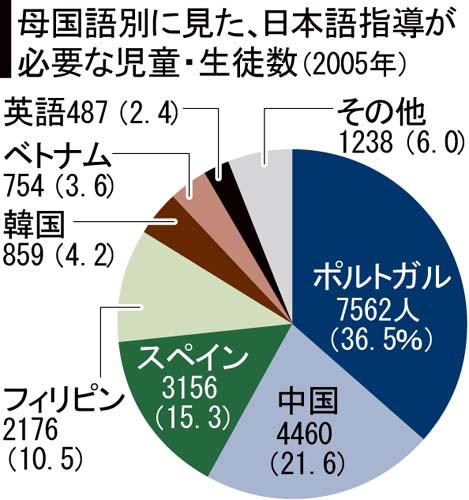mytest
Hi Blog. Got another report coming out in tomorrow regarding other ways Japan’s education system is letting immigrant children down. Meanwhile, here’s an article in the Yomiuri about the lack of apparatus to deal with the language barrier. For what it’s worth, in my grade school we had remedial classes for native Spanish speakers. And this was back in the early 1970’s. C’mon, Japan, you bring people over here, you take care of them. You didn’t foresee them having children, for crying out loud? Debito in Sapporo
===============================
20,000 in language pickle / Foreign students in need of specialized Japanese teachers
The Yomiuri Shimbun May. 22, 2007
http://www.yomiuri.co.jp/dy/national/20070522TDY01002.htm
Original Japanese blogged here
The number of foreign students in need of Japanese-language instruction in 885 municipalities exceeded 20,000 as of 2005, and the figure continues to increase, a government survey has found.
The Education, Science and Technology Ministry has produced guidebooks for language teaching, but most public primary, middle and high school teachers have little experience in teaching Japanese as a second language. Experts have pointed out the need for teachers who specialize in teaching Japanese to foreign children.
In Oizumimachi, Gunma Prefecture, about 6,800 of the town’s 42,000 residents are foreigners, and about 10 percent of all students in the seven public primary and middle schools hail from overseas.
Apart from regular classes, the schools also offer Japanese classes to increase foreign students’ language abilities. But the classes are taught by regular teachers who are not trained in language teaching.
An Oizumimachi Municipal Board of Education official said, “Although we’ve hired people who speak Portuguese or Spanish to help out [in the classroom], it would be hard to say our support for teachers is sufficient.”
At Okubo Primary School in Shinjuku Ward, Tokyo, more than half the 180 students come from South Korea, China, the Philippines and other countries.
“Even if these students can speak Japanese in everyday situations, acquiring the fluency that enables them to study in Japanese takes more time,” Principal Fumiko Nagaoka said.
According to the ministry, the number of foreign students who needed extra Japanese-language training in 1991 was 5,463, and exceeded 10,000 in 1993. As of 2005, the figure stood at 20,692, accounting for about 30 percent of all foreign students.
The largest group among the students are native Portuguese speakers, accounting for 37 percent, followed by those speaking Chinese (22 percent), and Spanish (15 percent).
This is a consequence of the 1990 revision of the Immigration Control and Refugee Recognition Law that allowed foreigners of Japanese descent to work in Japan, which was previously banned. The revision pushed up the number of people entering the country, mainly from South America.
However, the children of such people often stop attending school due to language difficulties, or find it hard to secure jobs after graduating from school.
The ministry has produced manuals for teachers to help them provide language lessons in conjunction with other subjects. A version of the manual was introduced for primary schools in 2003, and for middle schools in March this year.
The manual for middle school teachers says that setting riddles and playing other word games during Japanese classes can help foreign students increase their vocabulary, and that creating a dictionary of unknown words for students also can be helpful.
Only 70 of the 885 municipalities have specialized Japanese teachers. The ministry plans to expand the teacher-training system to cover Japanese-language instruction.
Prof. Ikuo Kawakami of Waseda University said: “In the United States and Australia, there’s a system to foster teachers to teach English to children who can’t speak the language. Japan should introduce a similar system and dispatch expert teachers to schools.”
ENDS
